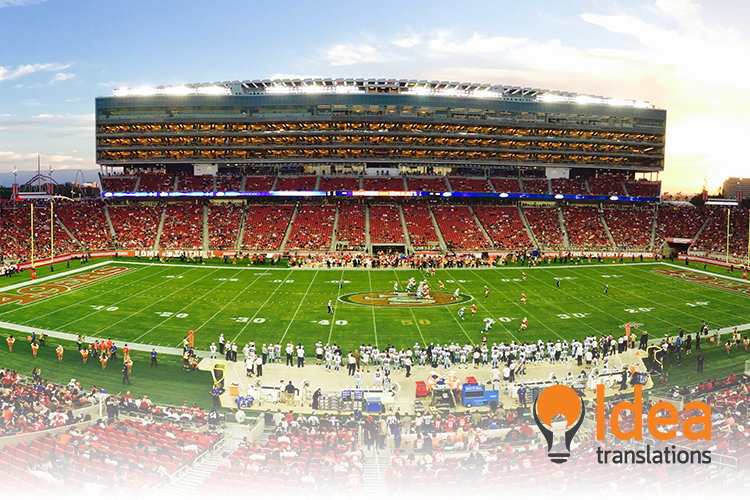
Super Bowl: A Multicultural Event Beyond Sports
Like rugby in New Zealand and football (soccer) in Argentina, the final game of the National Football League (NFL) in the United States is a massive event. The first Super Bowl took place 56 years ago and, since then, it has grown beyond the area of sports to become a whole social and cultural phenomenon.
How did the final game of the football season —between Los Angeles Rams and the Cincinnati Bengals— achieve 117 million viewers in the US only and became a symbol of multiculturalism?
An Event with a 50-Year History
Since football sponsor and former owner of the Kansas City Chiefs, Lamar Hunt, re-named it “Super Bowl” to differentiate it from other leagues, this game’s tradition has been growing for more than five decades. The largest sporting and entertainment event in the United States has become a cultural phenomenon and its legacy grows every second Sunday in February.
Thus, year after year, the Super Bowl has attracted a wider and more diverse audience of millions, not only in the United States but also globally.
The most-watched Super Bowl was the 2015 edition, between the New England Patriots and the Seattle Seahawks: it attracted an average of 114.4 million viewers in the US and between 30 and 50 million more at a global level.
Source: The18
This event, that started in 1967 as a match between the winners of the National Football Conference (NFC) and the American Football Conference (AFC), gained popularity thanks to several milestones and key personalities:
- Max McGee, with the Green Bay Packers, scored the first touchdown in Super Bowl history: the Green Bay Packers were the first league champions after defeating the Kansas City Chiefs by 35-10.
- Chuck Noll is the lead winning coach in Super Bowl history: he took the prize with the Pittsburgh Steelers four times, in 1975, 1976, 1979 and 1980.
- Mike Lodish (retired in 2000) played six Super Bowl games, more than any other player: he played four of them with the Buffalo Bills (1991-1994) and two with the Denver Broncos (1998-1999).
- Jerry Rice scored the greatest number of points in Super Bowl history: 42 points (seven touchdowns) in only three games.
- The longest field goal in Super Bowl history flew over 54 yards: the kicker was Steve Christie with the Buffalo Bills against Dallas in 1994.
- Tom Brady has more rings than any other NFL player, after winning his seventh championship in this year’s Super Bowl.
- The New England Patriots have won the Super Bowl a whooping number of seven times (the last time, in 2019), the same as the Pittsburgh Steelers, whose last title was in 2009.
All these names have created the myth surrounding the Super Bowl. However, the relevance of this event and its increasing popularity in recent years is not only a consequence of the action on the field. The way in which people from different cultures have identified with it has also extended its reach.
More than 30 million Hispanic Americans are NFL fans.
Source: USA Today
Cultural Interaction Inside and Outside the Stadium
In 2020, during the Super Bowl LIV, the multicultural nature of this celebration was made patent. The halftime show in the final at the Miami Hard Rock Stadium had Shakira and Jennifer Lopez as the main artists. The performance was a trailblazer: it included Latin music in an event that was watched live by 103 million people in the United States and received four Primetime Emmy nominations that year.
After the experience, Shakira said: “Miami is full of energy. And it’s a home to the “Latino community”. JLo, who has Puerto Rican heritage, added: “When I think of my daughter, and I think of all the little girls in the world who can have that, to see two Latinas sharing the absolute main stage; it is very inspiring for us”.
On the field, the Super Bowl has also reflected the changes in American society. In fact, the history of Latino participation in the NFL dates back to the 1920s, when Ignacio Saturnino “Lou” Molinet joined the Frankford Yellow Jackets in 1927.
In the 2020 season, 9% of the audience was of Latino origin (16.5 million viewers for every game minute).
Source: NYTimes
He is one of many Latino players and Hall of Famers (such as Joe Aguirre, Eddie Saenz, Steve Van Buren, Tom Fears, Danny Villanueva, “Mean” Gene Brito, Gabe Rivera, Efrén Herrera, Luis Sharpe, Ralph Ortega, Tony Casillas, Tony Romo and Tony Gonzalez) who left an indelible mark in Super Bowl history.
Tom Flores was the backup quarterback of the Kansas City Chiefs in their 1969 win against the Minnesota Vikings, and then became the first minority coach to win a Super Bowl (he won it twice as the coach of the Oakland Raiders). Louis Vasquez played for the Denver Broncos in two Super Bowls, and another legend of the game is Jim Plunkett, who was the MVP in the Super Bowl XV, where the Oakland Raiders won over the Philadelphia Eagles 27-10.
Sports to Bring Us Closer Together
The Super Bowl transcends borders also in the world of marketing. Every year, brands wrestle each other for a spot in the almost 4 hours of the Super Bowl broadcast to reach the massive multi-ethnic audience available.
In 2022, sponsors had to pay an average USD 6.5 million to advertise for 30 seconds during the Super Bowl LVI.
Source: Statista
Diversity and inclusion are ever-present topics in advertisement during the big NFL final, and current topics always make some of the pieces, such as Black Lives Matter and the issues of the LGBTQ+ community.
As often happens, sports are a way to break down barriers and follow the beat of social change. With its increasingly diverse audience, the Super Bowl has a well-earned and surely long-lived place in history



